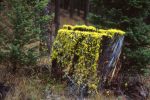Kodak Ektachrome E100
Ever since the end of Kodachrome I’ve been using colour negative film almost exclusively. Because of this I’ve become accustomed to looking at developed film that has an orange mask, in addition to being a negative. That’s why looking at this roll of Kodak E100 slide film was such a joy. It created a similar feeling for me as getting back a box of mounted Kodachrome once did. Holding the images up to sunlight and seeing the colour was a pleasure. Once scanned and viewed on the computer some of that charm is tempered. Its not the fault of the film but reduced to a digital form there is a degree of equalization between it and a digital camera capture. During scanning I was also reminded of another of the differences from colour negatives. Anything opaque on the film during scanning shows up as black instead of white. That too felt familiar as years ago I scanned thousands of family slides (Mostly Kodachrome)
After the scanning and dust removal it was time to evaluate the images. The colours were accurate if not perhaps a little flat. I found I needed to add a touch of saturation and contrast but little else to bring them in line with direct viewing. The bulk of slides that I had ever shot being on Kodachrome 64 I was surprised by the details in the shadows. This emulsion has a much broader dynamic range. You can see into darker areas without blowing out the highlights. Back with Kodachrome it was almost a binary decision, you could have highlights or shadows but not both.
Yes I’ve been invoking Kodachrome a lot, largely because that is what I was familiar with. In reality though the similarities are primarily around being positive film. When compared to a digital capture Ektachrome 100 could be considered much like a JPEG, with most of its character baked in, with the ability to only make some small adjustments. So yes using this film is less forgiving than shooting a modern digital camera in RAW but that’s not a bad thing.
Seeing as you cant put film in a digital camera even if you wanted to its a great excuse to use a great film in a great old camera. What I’m suggesting by that is this film, while somewhat forgiving, is best used in a camera with an accurate exposure system. On the downside is the cost, retailing at around $20 a roll, if you add on developing it becomes very close to $1 per shot which is in the same territory as instant film. Personally I consider it worth it, maybe not for everyday snaps but when it matters I will pull a roll out of the fridge.
 I shot this roll in a Pentax MZ6 SLR with a variety of lenses including one originally intended for smaller APSc digital sensors. Its the DA*60-250. I haven’t done anything to mine and you can see that there is mechanical vignetting in the corners. Some people do remove the baffling at the rear of the lens which eliminates the vignette and makes the lens effectively compatible with 35mm film. I don’t expect to be using it that much for film or a larger sensor so will leave it as is.
I shot this roll in a Pentax MZ6 SLR with a variety of lenses including one originally intended for smaller APSc digital sensors. Its the DA*60-250. I haven’t done anything to mine and you can see that there is mechanical vignetting in the corners. Some people do remove the baffling at the rear of the lens which eliminates the vignette and makes the lens effectively compatible with 35mm film. I don’t expect to be using it that much for film or a larger sensor so will leave it as is.





























August 1st, 2020 at 10:13 am
[…] A nice pairing of a great camera and a great film. What could go wrong? Well I’m not sure but I seem to have over exposed the images a bit as well as have a few light leaks. I also did my own developing to throw another variable in there. I think that with colour negative film the over exposure wouldn’t have been an issue but slide film demands a higher level of accuracy. Just the same I like the look it has a slightly washed out appearance that looks like older slides (not Kodachrome) as well as leaning towards blue. For posts about the Yashica GX look here and about Ektachrome E100 here […]